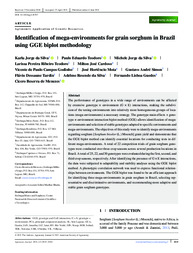Identification of mega-environments for grain sorghum in Brazil using GGE biplot methodology.
Identification of mega-environments for grain sorghum in Brazil using GGE biplot methodology.
Author(s): SILVA, K. J. da; TEODORO, P. E.; SILVA, M. J. da; TEODORO, L. P. R.; CARDOSO, M. J.; GODINHO, V. de P. C.; MOTA, J. H.; SIMON, G. A.; TARDIN, F. D.; SILVA, A. R. da; GUEDES, F. L.; MENEZES, C. B. de
Summary: The performance of genotypes in a wide range of environments can be affected by extensive genotype × environment (G × E) interactions, making the subdivision of the testing environments into relatively more homogeneous groups of locations (mega-environments) a necessary strategy. The genotype main effects + genotype × environment interaction biplot method (GGE) allows identification of megaenvironments and selection of stable genotypes adapted to specific environments and mega-environments. The objectives of this study were to identify mega-environments regarding sorghum [Sorghum bicolor (L.) Moench] grain yield and demonstrate that the GGE biplot method can identify essential locations for conducting tests in different mega-environments. A total of 22 competition trials of grain sorghum genotypes were conducted over three crop seasons across several production locations in Brazil. A total of 25, 22, and 30 genotypes were evaluated during the first, second, and third crop seasons, respectively. After identifying the presence of G × E interactions, the data were subjected to adaptability and stability analyses using the GGE biplot method. A phenotypic correlation network was used to express functional relationships between environments. The GGE biplot was found to be an efficient approach for identifying three mega-environments in grain sorghum in Brazil, selecting representative and discriminative environments, and recommending more adaptive and stable grain sorghum genotypes
Publication year: 2021
Types of publication: Journal article
Unit: Embrapa Mid-North
Keywords: Genótipo, Grão, Método biplot, Rendimento, Sorgo
Observation
Some of Embrapa's publications are published as ePub files. To read them, use or download one of the following free software options to your computer or mobile device. Android: Google Play Books; IOS: iBooks; Windows and Linux: Calibre.
Access other publications
Access the Agricultural Research Database (BDPA) to consult Embrapa's full library collection and records.
Visit Embrapa Bookstore to purchase books and other publications sold by Embrapa.

